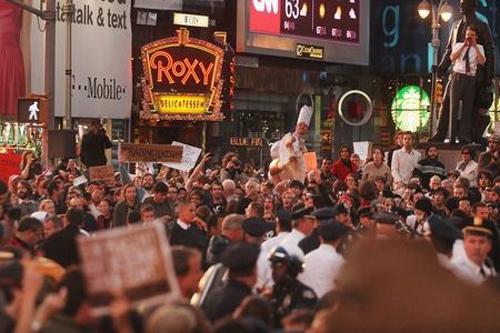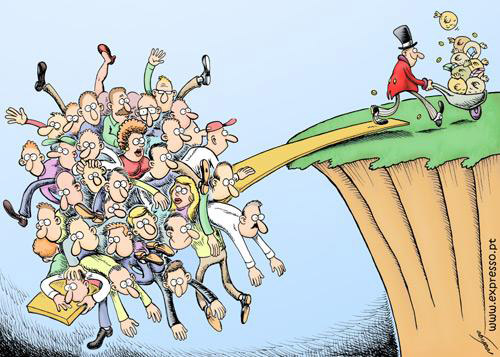The media is having a field day when it comes to reporting on Occupy Wall Street (OWS). Presented with a neat and clean narrative that they can hysterically massage into a controversy, they’ve delightfully contrasted Occupy Wall Street with the Tea Party protests. To hear lazy reporters talk, one would think that the hundreds of thousands of OWS protestors across the world could be easily compared to the relatively tiny Tea Party movement that’s despised abroad and is generally unpopular even in the US. While they share the common vein of being angry at the current system and the direction the country is heading, most of the similarities end there.
Grassroots Vs. Astroturf

While Tea Party members criticize Occupy Wall Street for not taking the initiative, finding a job, and bettering the system, the statement is hilariously hypocritical. Tea Party members didn’t really do anything on their own; they were funded by large, corporate political organizations. For example, FreedomWorks, an organization which received $12 million from the Koch foundations, was largely behind starting the Tea Party movement. The Koch family is accused of using the Tea Party to execute their own conservative agenda, and have given millions and millions of dollars to conservative causes and institutions which have, in turn, funded the Tea Party. Now, of course, the thousands that eventually turned out for the Tea Party protests were motivated by a genuine desire to change a system they viewed as heading in the wrong direction, there’s no getting around the fact that they had a metric buttload of seed capital to start up, not to mention their own news network. Occupy Wall Street started out with a handful of people and Facebook. Even the Unions, the great boogeymen of the Right, didn’t get behind the protests until they were well advanced. Occupy Wall Street is grass the grew naturally from the people’s anger and frustration. The Tea Party is grass that grew on a well-manicured lawn with several tons of horseshit (for fertilizer).
Representation

While the claim by Occupy Wall Street protestors that they represent “The 99%” of this country is a little bit audacious, insisting that the rich pay more than the middle class in taxes and quit mucking around with elections is actually pretty well in line with the interests of about 99% of the country. Most of us don’t have the power to buy elections, most of us don’t get the majority of our income from capital gains, and most of us make well under the $350,000 salaries that the 1% do. Regardless of your position on government intervention in the economy and programs like Obamacare, they are designed to help the majority of Americans. Whereas take a look at the six principals of the Tea Party Express–widely considered the largest and most influential branch of the Tea Party. While a lot of these look good on paper (who doesn’t like lower taxes?) the beneficiaries will be disproportionately laughing from their yachts atop piles of money. Where Occupy Wall Street argues for policies that will hopefully help large majorities of the population, the Tea Party is busy pressuring representatives to cut off people’s unemployment and disaster relief for victims of a hurricane and an earthquake.
Age

While the Tea Party movement and OWS actually have a lot of similarities in principle once you get past the shrillness, one of the biggest differences between the two is the yawning age gap between participants. Only 10% of Tea Partiers are under the age of 34, and most are over the age of 45. OWS on the other hand has a much younger profile, but 35% of them are still over the age of 34. This is a generational struggle, there’s no denying that, but OWS represents a much more even slice of the population, and doesn’t just seem to be older people holding up bafflingly offensive signs like this.
Popular Support

Despite some people’s attempt to make OWS look like a bunch of entitled, unemployed hippies who hate capitalism, America and Grandma’s apple pie, apparently a lot of Americans aren’t buying it. Favorable opinions of the OWS keep creeping toward the majority, while favorable opinions of the tea party still struggle to stay above the percentage of people who think they’re mean and creepy. But looking past the movements themselves, policies that are generally supported by OWS—such as better regulation, a more progressive tax system, and no more bank bailouts—enjoy resounding support in the 60%-70% range. To put into perspective just how rare it is that 60% of Americans will agree on even anything, 73% of Americans agree the super rich should pay more in taxes while only 58% believe Obama wasn’t born in Kenya, by a margin of 15%. And that includes 66% of Republicans. It’s not 99% by a long shot, but in American politics it’s as rare as Rick Perry making sense.
OWS Actually Protests

A quick primer on non-violent resistance. It’s spiritual fathers are widely considered to be historical characters such as Gandhi, Martin Luther King Jr. and Henry David Thoreau. All three of these people advocated civil disobedience, which basically involves breaking the law in a non-violent manner and peacefully going to jail for your crimes. In a word, the whole point is to break the law in a peaceful manner to draw attention to your cause—usually because of the disproportionately violent crackdown from the government. Otherwise, your protest is little more than a louder, more annoying bumper sticker.
Hundreds, if not thousands of protesters have been arrested during Occupy protests, often as the result of some pretty shady actions on the part of the Police. Not to mention the peaceful protesters who were pepper sprayed or seriously injured by overzealous police forces. It’s obviously important to note that breaking the law and fostering mayhem aren’t good in and of themselves, but when a system is so broken that people feel like they’re only way to get noticed is to block traffic on the Brooklyn bridge, that’s a real protest. That’s being mad as hell and not taking it anymore, despite the fact that you might get tear gassed and shot with rubber bullets without warning.
OWS Are Not Unemployed

Anyone who has been to an OWS protest know that there are usually quite a lot of unemployed people in the crowd. There’s two ways to spin this, one is that they’re lazy, shiftless hippies demanding government handouts. The other is that they’ve been screwed over by a system designed to benefit the rich and bend the middle class over a chair. Or you could not bother spinning it at all because 70% of OWS protesters are employed. That’s in contrast to only 56% of Tea Partiers who have jobs. To be fair, those 44% of Tea Partiers that are unemployed are most likely retired. Though it’s hard to entertain calls for a smaller government and critiques of OWS being lazy, Unemployment-collecting ruffians from a group of people collecting gob-smacking amounts of money (close to $1 trillion a year) in Social Security and Medicare. Especially when the people paying for those programs are the 70% employed younger people at the OWS protests.
OWS is Better-Educated

While it’s unfair to correlate intelligence with level of education, it’s certainly interesting to see the breakdown of education between OWS and the Tea Party. A staggering 92% of OWS protesters have college degrees, in contrast to 70% for the Tea Party. Again, like employment, this is likely the result of a generational gap rather than OWS attracting more college-educated people. When many in the Tea Party demographic were of college age, enrollment rates were anywhere from 10%-15% lower. But it does illustrate an interesting fact, namely that OWS isn’t the rambling hippie caravan it’s made out to be, and is likely made up of educated young professionals who feel absolutely robbed by the system. This is the demographic, by the way, that starts revolutions.
OWS Have Numbers to Back up Their Arguments

While OWS hasn’t really published an over-arching manifesto stating what they believe, and the signs at rallies can range from Libertarian to Liberal to Anarchist and everything in between, a couple of salient points have emerged as the main arguments behind the movement, the big one being:
• Rising income inequality and the lack of growth in wages for 80% of the country over the past few decades reveals a fundamental inequality between the top 10% of wage earners and the rest of us.
Similarly, while the Tea Party is still somewhat loosely-organized, a couple of over-arching arguments have emerged, the big one being:
• LESS. TAXES. We are Taxed Enough Already.
Let’s start with the Tea Party, namely, do will lower tax rates make things better overall, and are the truly onerous right now? The answer to both: No. Tax rates are at their lowest point since the depression, and there’s little political will to raise them even slightly. While there are a few tax rates such as the corporate income tax, and arguably FICA taxes, that are too high right now, federal income taxes are so low, 47% of Americans pay no federal income tax at all. And while lowering taxes is one good way to stimulate the economy in a depression, they really don’t have much lower to go for the majority of the country, meaning that no one would end up spending more. Plus a rise in taxes will almost certainly be needed to balance the budget, and economists have shown that raising taxes leads to greater economic growth (or to be more precise, slightly less slower) than spending cuts.
Turning to OWS, is there systemic inequality emerging in America, not just in wages, but in people’s ability to increase their wages and advance? In a word: Yes. It’s a well-studied fact that the middle class has been shrinking, and wages for everyone who isn’t a millionaire have stagnated since Reagan. Essentially, the rich have been getting progressively richer, while the poor and middle class have been getting poorer. And they have been using this wealth to game the everloving shit out of the system to further increase their wealth, oh and to buy politicians left and right using a variety of shady methods.
Income

When it comes to income, the Tea Party has the OWS protesters walloped. Only 13% of the Tea Party makes less than $50,000 a year, and 31% earn over $75,000 a year. OWS on the other hand, is 66% made up of people earning less than $50,000 a year. Again, this is probably the result of a generational gap, as one of the surest guarantees of finding higher earners is to go up in age. Unfortunately, this is not helping the Tea Partier’s arguments when they’ve enjoyed decades of a growing economy, accumulated some wealth, and now seem to barely care that the cost of college is hovering somewhere out by Pluto. Of course the vast, vast majority of Tea Partiers earnestly think that lowering taxes and shrinking government will be to the benefit of all. However, to the younger OWS protesters who are now forced to struggle in the bedlam left behind, “Taxed enough already” and “End Obamacare” sound like poorly-translated versions of “Fuck You. Got Mine.”
Redistribution and Hypocrisy

Between 1984 and 2009, the average net worth of Americans under 35 declined by 68%. At the same time, net worth for those over the age of 65 increased by 42%. There are a variety of causes for this, not the least of which being that the younger you get, the more minority and single-parenty you get. Also the collapses of the early 90s, 2000s and in 2008 haven’t helped. But one of the biggest is the fact that all young employed Americans pay a payroll tax, which goes directly to the older generation in the form of medicare and social security benefits, to the tune of about $1 trillion a year, as mentioned earlier. Oh and in case anyone forgot, the Tea Party formed around outrage at Obamacare, also known as a program that would give the young and middle-aged the same benefits as Medicare.
To put it plainly, OWS is paying and the Tea Party is collecting, and then the Tea Party is complaining about the taxes while reaping the benefits and furiously denying them to others. Especially in this light, it’s no wonder that OWS has ballooned, one of its largest protests so far in Oakland has grown to well over 100,000 people.
